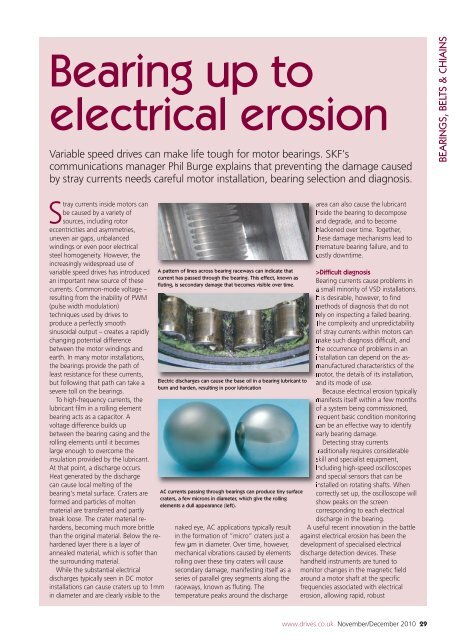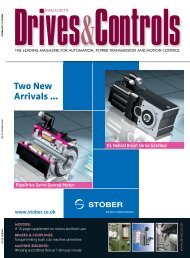New Danfoss VLT® Decentral Drive E cient, reliable and powerful
New Danfoss VLT® Decentral Drive E cient, reliable and powerful
New Danfoss VLT® Decentral Drive E cient, reliable and powerful
You also want an ePaper? Increase the reach of your titles
YUMPU automatically turns print PDFs into web optimized ePapers that Google loves.
Bearing up to<br />
electrical erosion<br />
Variable speed drives can make life tough for motor bearings. SKF’s<br />
communications manager Phil Burge explains that preventing the damage caused<br />
by stray currents needs careful motor installation, bearing selection <strong>and</strong> diagnosis.<br />
BEARINGS, BELTS & CHIAINS<br />
Stray currents inside motors can<br />
be caused by a variety of<br />
sources, including rotor<br />
eccentricities <strong>and</strong> asymmetries,<br />
uneven air gaps, unbalanced<br />
windings or even poor electrical<br />
steel homogeneity. However, the<br />
increasingly widespread use of<br />
variable speed drives has introduced<br />
an important new source of these<br />
currents. Common-mode voltage –<br />
resulting from the inability of PWM<br />
(pulse width modulation)<br />
techniques used by drives to<br />
produce a perfectly smooth<br />
sinusoidal output – creates a rapidly<br />
changing potential difference<br />
between the motor windings <strong>and</strong><br />
earth. In many motor installations,<br />
the bearings provide the path of<br />
least resistance for these currents,<br />
but following that path can take a<br />
severe toll on the bearings.<br />
To high-frequency currents, the<br />
lubricant film in a rolling element<br />
bearing acts as a capacitor. A<br />
voltage difference builds up<br />
between the bearing casing <strong>and</strong> the<br />
rolling elements until it becomes<br />
large enough to overcome the<br />
insulation provided by the lubricant.<br />
At that point, a discharge occurs.<br />
Heat generated by the discharge<br />
can cause local melting of the<br />
bearing’s metal surface. Craters are<br />
formed <strong>and</strong> particles of molten<br />
material are transferred <strong>and</strong> partly<br />
break loose. The crater material rehardens,<br />
becoming much more brittle<br />
than the original material. Below the rehardened<br />
layer there is a layer of<br />
annealed material, which is softer than<br />
the surrounding material.<br />
While the substantial electrical<br />
discharges typically seen in DC motor<br />
installations can cause craters up to 1mm<br />
in diameter <strong>and</strong> are clearly visible to the<br />
A pattern of lines across bearing raceways can indicate that<br />
current has passed through the bearing. This effect, known as<br />
fluting, is secondary damage that becomes visible over time.<br />
Electric discharges can cause the base oil in a bearing lubricant to<br />
burn <strong>and</strong> harden, resulting in poor lubrication<br />
AC currents passing through bearings can produce tiny surface<br />
craters, a few microns in diameter, which give the rolling<br />
elements a dull appearance (left).<br />
naked eye, AC applications typically result<br />
in the formation of “micro” craters just a<br />
few μm in diameter. Over time, however,<br />
mechanical vibrations caused by elements<br />
rolling over these tiny craters will cause<br />
secondary damage, manifesting itself as a<br />
series of parallel grey segments along the<br />
raceways, known as fluting. The<br />
temperature peaks around the discharge<br />
area can also cause the lubricant<br />
inside the bearing to decompose<br />
<strong>and</strong> degrade, <strong>and</strong> to become<br />
blackened over time. Together,<br />
these damage mechanisms lead to<br />
premature bearing failure, <strong>and</strong> to<br />
costly downtime.<br />
>Difficult diagnosis<br />
Bearing currents cause problems in<br />
a small minority of VSD installations.<br />
It is desirable, however, to find<br />
methods of diagnosis that do not<br />
rely on inspecting a failed bearing.<br />
The complexity <strong>and</strong> unpredictability<br />
of stray currents within motors can<br />
make such diagnosis difficult, <strong>and</strong><br />
the occurrence of problems in an<br />
installation can depend on the asmanufactured<br />
characteristics of the<br />
motor, the details of its installation,<br />
<strong>and</strong> its mode of use.<br />
Because electrical erosion typically<br />
manifests itself within a few months<br />
of a system being commissioned,<br />
frequent basic condition monitoring<br />
can be an effective way to identify<br />
early bearing damage.<br />
Detecting stray currents<br />
traditionally requires considerable<br />
skill <strong>and</strong> specialist equipment,<br />
including high-speed oscilloscopes<br />
<strong>and</strong> special sensors that can be<br />
installed on rotating shafts. When<br />
correctly set up, the oscilloscope will<br />
show peaks on the screen<br />
corresponding to each electrical<br />
discharge in the bearing.<br />
A useful recent innovation in the battle<br />
against electrical erosion has been the<br />
development of specialised electrical<br />
discharge detection devices. These<br />
h<strong>and</strong>held instruments are tuned to<br />
monitor changes in the magnetic field<br />
around a motor shaft at the specific<br />
frequencies associated with electrical<br />
erosion, allowing rapid, robust<br />
www.drives.co.uk November/December 2010 29




